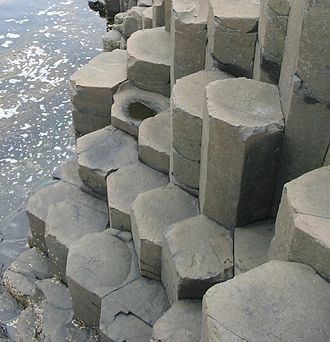Lava

File:007 Volcano eruption of Litli-Hrútur in Iceland in 2023 Video by Giles Laurent.webm



Lava is a molten rock that erupts onto the Earth's surface from a volcano or through a fissure, the latter being known as a volcanic vent. It is a primary feature of volcanic activity and plays a crucial role in the shaping of Earth's lithosphere. Upon cooling and solidification, lava forms igneous rock, which can be either basaltic, andesitic, dacitic, or rhyolitic, depending on its chemical composition and the rate of cooling.
Formation[edit]
Lava is formed when magma—molten rock located beneath the Earth's surface—rises due to buoyancy or external pressure, causing it to erupt through volcanoes or fissures. The temperature of erupting lava typically ranges from 700°C to 1,200°C (1,292°F to 2,192°F) depending on its composition. Basaltic lava, which has a low silica content, is hotter and more fluid than rhyolitic lava, which has a high silica content and is more viscous.
Types of Lava[edit]
Based on its viscosity and temperature, lava can be classified into several types:
- Pāhoehoe - A Hawaiian term for basaltic lava with a smooth, unbroken surface. It is relatively fluid and can form rope-like, smooth textures.
- ʻAʻā - Also originating from Hawaiian terminology, ʻAʻā describes basaltic lava that is more viscous than pāhoehoe, characterized by a rough, clinkery surface.
- Pillow lava - Forms when lava erupts underwater, leading to rounded structures that resemble pillows. This type is common at mid-ocean ridges and in ancient underwater volcanic sequences.
- Block lava - Has a higher viscosity than ʻAʻā and forms from andesitic or dacitic lava, characterized by a surface of smooth, large blocks.
- Lava domes - Result from the slow extrusion of viscous lava from a volcano, forming a dome-shaped feature.
Hazards[edit]
Lava flows pose significant hazards to life, property, and infrastructure. Their destructive force can obliterate everything in their path, although the speed of flow varies greatly depending on the type of lava and the slope of the terrain. Basaltic lava flows, being more fluid, can cover vast areas and travel at higher speeds. In contrast, more viscous lava flows, such as those from rhyolitic or dacitic eruptions, move slowly and tend to cover smaller areas but can still cause significant damage.
Cultural and Scientific Importance[edit]
Lava has played a significant role in shaping the Earth's surface and is of great interest to geologists who study its composition, flow patterns, and the structures it forms to understand the Earth's volcanic activity and history. Culturally, lava is significant in many regions with active or historic volcanic activity, where it is often intertwined with local mythology and regarded with respect and awe.
Ad. Transform your life with W8MD's Budget GLP-1 injections from $75


W8MD offers a medical weight loss program to lose weight in Philadelphia. Our physician-supervised medical weight loss provides:
- Weight loss injections in NYC (generic and brand names):
- Zepbound / Mounjaro, Wegovy / Ozempic, Saxenda
- Most insurances accepted or discounted self-pay rates. We will obtain insurance prior authorizations if needed.
- Generic GLP1 weight loss injections from $75 for the starting dose.
- Also offer prescription weight loss medications including Phentermine, Qsymia, Diethylpropion, Contrave etc.
NYC weight loss doctor appointmentsNYC weight loss doctor appointments
Start your NYC weight loss journey today at our NYC medical weight loss and Philadelphia medical weight loss clinics.
- Call 718-946-5500 to lose weight in NYC or for medical weight loss in Philadelphia 215-676-2334.
- Tags:NYC medical weight loss, Philadelphia lose weight Zepbound NYC, Budget GLP1 weight loss injections, Wegovy Philadelphia, Wegovy NYC, Philadelphia medical weight loss, Brookly weight loss and Wegovy NYC
|
WikiMD's Wellness Encyclopedia |
| Let Food Be Thy Medicine Medicine Thy Food - Hippocrates |
Medical Disclaimer: WikiMD is not a substitute for professional medical advice. The information on WikiMD is provided as an information resource only, may be incorrect, outdated or misleading, and is not to be used or relied on for any diagnostic or treatment purposes. Please consult your health care provider before making any healthcare decisions or for guidance about a specific medical condition. WikiMD expressly disclaims responsibility, and shall have no liability, for any damages, loss, injury, or liability whatsoever suffered as a result of your reliance on the information contained in this site. By visiting this site you agree to the foregoing terms and conditions, which may from time to time be changed or supplemented by WikiMD. If you do not agree to the foregoing terms and conditions, you should not enter or use this site. See full disclaimer.
Credits:Most images are courtesy of Wikimedia commons, and templates, categories Wikipedia, licensed under CC BY SA or similar.
Translate this page: - East Asian
中文,
日本,
한국어,
South Asian
हिन्दी,
தமிழ்,
తెలుగు,
Urdu,
ಕನ್ನಡ,
Southeast Asian
Indonesian,
Vietnamese,
Thai,
မြန်မာဘာသာ,
বাংলা
European
español,
Deutsch,
français,
Greek,
português do Brasil,
polski,
română,
русский,
Nederlands,
norsk,
svenska,
suomi,
Italian
Middle Eastern & African
عربى,
Turkish,
Persian,
Hebrew,
Afrikaans,
isiZulu,
Kiswahili,
Other
Bulgarian,
Hungarian,
Czech,
Swedish,
മലയാളം,
मराठी,
ਪੰਜਾਬੀ,
ગુજરાતી,
Portuguese,
Ukrainian
